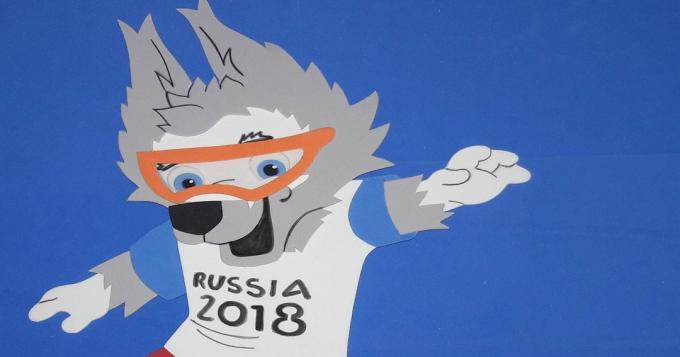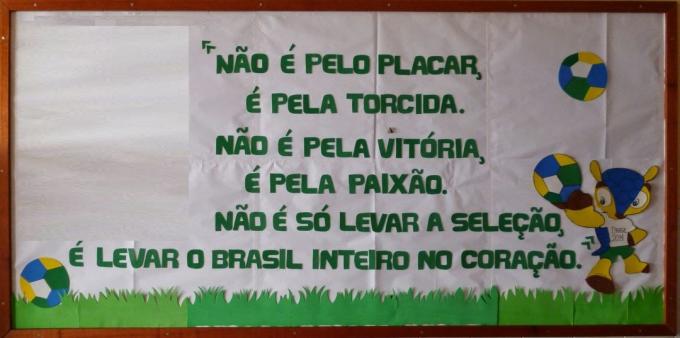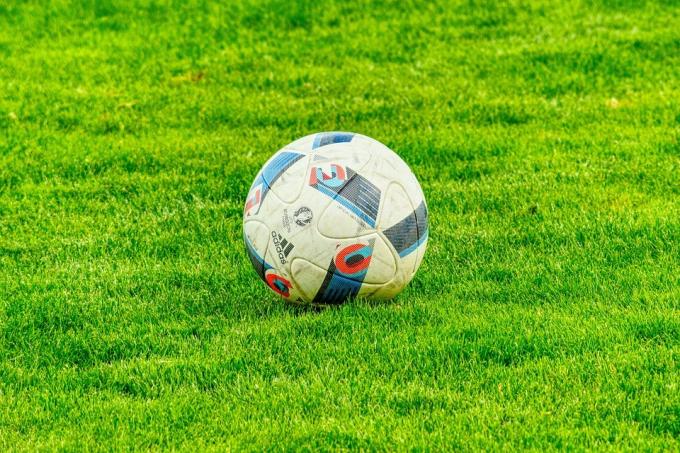In this post, we selected some models, ideas and suggestions for your World Cup Project. They are excellent resources for working the World Cup in the classroom, especially with students from initial grades (Early Education and Elementary School).
FIFA Football World Cup began in 1928, during a FIFA congress, when Jules Rimet got approval to create an international tournament.
The Cup fulfills FIFA's goals of raising awareness in the world, developing the sport and building a better future in many different ways.
The World Cup is a football tournament held every four years by the International Football Federation (FIFA). Largest football event on the planet and second largest sports competition in the world in terms of audience, behind just from the Olympic Games, the World Cup touches billions of people and reaches the five continents of the globe. Know more: World Cup history.
And it was with this in mind that we selected these models for your World Cup Project, check out:
Index

In a World Cup year, it becomes impossible to develop projects and/or sequences of activities that avoid the subject. In our country, football mobilizes: Brazilians stop, vibrate, debate and cry.
Taking into account that the pedagogy of projects is based on the interests and needs of students, the World Cup, without a doubt, is a subject rich in possibilities. We must take advantage of all this mobilization to give more meaning to the classes, working in an interdisciplinary way and addressing current and transversal themes such as: Plurality Cultural, Environment, Health, Work and Consumption, which will allow children to discover different cultures, get to know various ethnic groups, valuing them and respecting them.
See also: World Cup Coloring Pages

2018 World Cup Project in Russia
Step by step:

In Brazil I wear the shirt 
The World Cup is ours: 
It's not for the score, it's for the fans. It's not for the victory, it's for the passion. It's not just taking the team, it's taking the whole of Brazil in the heart. 
World Cup: 
All together towards hex:
Some messages can be posted on your wall, check out suggestions:
With information from the blog: Teacher: Ivani Ferreira

World Cup garden project
To explore, discover and apprehend reality, the child uses games and make-believe. Playing is, for the child, the result of self-discovery, pleasure and growth.
Activity 01: The ball is a toy very much appreciated by children of any age, which is why it was privileged in this project; in addition, we work on motor coordination.
Activity 02: At first, all students received a ball to play freely in the school yard.
Activity 03: The students formed a circle, sitting on the floor. We talked about various types, sizes and textures of the balls that were in high school.
Activity 04: To the sound of music, we made a circle and every two children got a ball to dance with, balancing it on their foreheads, stomachs and buttocks.
Activity 05:
Activity 06: With the balls that we make in semi-fine, we played games like bowling, target shooting, and basket ball.
Activity 07: Each child received a gas balloon to play freely in the room. Afterwards, we tie the badge to the balloon rope to make the call. It was very funny.
Activity 08: With a hoop hoop we made the basketball game.
Activity 09:
We realized that the group relationships in this project were widely disseminated, stimulating affection and sharing. The most repeated and appreciated activity by children was that to balance the ball on a part of the body. This experience was gratifying for the children and us, the teachers, because in addition to helping with motor development, it stimulated and challenged students to overcome obstacles with great joy.

World Cup Project for Maternal
Football is one of the greatest passions of the Brazilian people. Even winning or losing people continue with the passion. When it comes to the World Cup, everyone pays attention to root for their country, no matter where it is, all nations unite and accompany this great event.
visit a football field
Ethic: Approaching the union of peoples through the World Cup, respect between students and the rules, working on the concept that you don't always win. Through defeats we draw new strategies.
Environment: Observe the places and changes because of the crown (ornaments), find positive points (twisted) and negative (dirt).
Cultural plurality: Check if you have customs from other countries that we inherit. Search for some idols and assemble a panel of football idols from different countries.
– National Anthem (making the anthem with pictures related to the words).
Material: Earth globe, 1 white cardboard, gouache (green, blue, yellow, white).
Material: Cardboard, Data show.
Material: Paper White Cardboard (2), gouache (blue, green, red, white).
Material: Sound and music.
Material: Date show.
Cooking: students will get to know a little of typical food
– Italy (Matt. A): will do Polenta
Bring the water to a boil and add the salt and butter. As soon as it starts to boil, start adding the cornmeal little by little, stirring constantly so that it doesn't lump. After all the cornmeal, continue to stir regularly. For perfect cooking, the polenta is ideal to cook for 30 minutes over low heat. Pour into a baking dish and sprinkle with Parmesan, covering with the sauce of your choice.
Tour to the Football Field. Students will have a moment of fun and knowledge to get to know what a field is like and what you want in it: grass, beam, scratches on the ground, geometric shapes, bleachers, etc.
Material: Wooden box, grass seed, plastic doll, plastic paint.
Material: White (20) card stock, gouache (yellow, light blue, dark blue).
Material: Styrofoam Ball (2 Large), Gouache (Black, White).
Souvenir making: students will make a mini-cup for the day. Students will make the base with colored biscuit and Styrofoam ball. Students will develop kneading movement and creativity.
Material: Colored Biscuit (20), Styrofoam Ball (20 Small - Ping pong).
Material: Parent survey.
Reproduction of the tourist spot:
Material: Styrofoam Plate (2 Thick), gel, clay, landscape.
Material: Yellow ice cream stick (1,000), golden glitter.
Assembly of the memory game with the flag of the countries worked with a milk carton and string.
Material: Milk carton (6), string, flags (EVA).
17th Activity
Cropping of fans in the cup. Parents will send several fan figures to assemble the stands for the football field. Facial expressions (happy, sad, screaming) will be worked on.
Material: National Anthem, Figures, glue, white cardboard (2).
Making the mascot, the students chose a mascot to accompany throughout the project.
Material: Pet Options.
Material: Colored Biscuit (20), Styrofoam Ball (20 Peq. - Ping pong).
Material: Parent survey.
Reproduction of the tourist spot:
Material: Styrofoam Plate (2 Thick), gel, clay, landscape.
Material: Yellow ice cream stick (1,000), golden glitter.
Assembly of the memory game with the flag of the countries worked with a milk carton and string.
Material: Milk carton (6), string, flags (EVA).
Cropping of fans in the cup. Parents will send several fan figures to assemble the stands for the football field. Facial expressions (happy, sad, screaming) will be worked on.
Material: National Anthem, Figures, glue, white cardboard (2).
Material: Pet Options.
Always thinking of making it easy for you, we decided to make the "World Cup Project for Maternal" shown above for download in PDF.
If you liked the post "World Cup Project for Maternal - Early Childhood Education", be sure to share with your friends on social networks and also leave a comment here on our website with your opinion and suggestions for other posts.



Also check:FOOTBALL DRAWINGS



We also recommend:
Subscribe to our email list and receive interesting information and updates in your email inbox
Thanks for signing up.